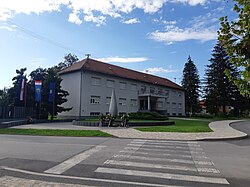History
World War II
During World War II, Glina was part of the Independent State of Croatia established by the Axis powers as a result of the Invasion of Yugoslavia. There were two major Ustashe massacres of Serbs in Glina in 1941. [4] On the night of 11 May, Ustaše arrested male Serbs over the age of sixteen, regardless of occupation or class. The men were first imprisoned in a small holding area of a former gendarmerie building, then on the night of 12 May, they were tied up in pairs, loaded into trucks and taken to a large pit where they were killed, primarily with guns. Historian Slavko Goldstein writes that "less than four hundred, but certainly higher than three hundred" were killed in total.
Another massacre occurred on 30 July-2 August when 700 Serbs were gathered under the threat of forced conversion and executed in the local Serbian Orthodox Church. [9] The dates as well as the number of victims in this massacre are disputed in sources. According to Italian reports, in total, more than 18,000 Serbs were killed in the district of Glina during the war. [10] The Yugoslav Partisans attacked Glina and Hrastovica in late November 1943. The position was held by the Nazi Germany army with support from the Danish 11th SS Volunteer Panzergrenadier Division Nordland. The Partisans liberated and entered the town on January 11, 1944. [11]
Socialist Yugoslavia
After the end of war in 1964, the Committee for the Construction of Memorials to the July Victims of Fascist Terror in Banija and Kordun sent a request to the Veterans Associations of the People’s Liberation War of Yugoslavia (SUBNOR) to finally build a memorial as the failure to do so was particularly affecting the brotherhood and unity of the people in this region. [4] A memorial house was thereafter built on the site of the destroyed Orthodox church and in 1985, its executive committee requested assistance in creating a permanent display for the museum which read: "the Ustasha slaughtered around 1,200 Serbs from the surroundings of Glina on August 2, 1941", noting that it marked the beginning of the Genocide of Serbs in the Independent State of Croatia. [4]
Yugoslav wars
In the early summer of 1991, the first major armed clashes between Croatian forces and rebelled Serbs took place in the Glina area. On June 26, a day after the declaration of independence of Croatia, a group of armed Serbs attacked the local police station. [12] The second armed attack followed a month later, on July 26. Serb militias were reported to have used ethnic Croats as human shields in the conflict. Civilians from both sides died as a result of the fighting in Glina. [12] Croatian Police and National Guard units had to withdraw while Croats from Glina (including Jukinac) took refuge in Donji and Gornji Viduševac, villages north of Glina that were free at the time. Subsequently, Glina was completely controlled by the Yugoslav People's Army and the Serb rebels. The remaining non-Serb population from Glina and the surrounding area were mostly expelled while many were taken to internment camps. During the war, Serbs occupied the territory up to the Kupa river, which was followed by many crimes against the civilians in Novo Selo Glinsko, Stankovci and Bučič area. [13] In 1995, future President of Serbia Aleksandar Vučić held a meeting in Glina during which he stated, among others that Glina would never be part of Croatia and advocated for it to be a part of Greater Serbia. [14] [15] A total of 396 Croatian civilians and soldiers were killed in Glina during the war. On 6 August 1995, Glina was returned to Croatia by the Croatian Army during Operation Storm. At the same time, most ethnic Serbs fled. In December 2015, the bodies of 56 Serb civilians and soldiers killed during the action were exhumed from a mass grave in the Gornje Selište municipality. [16]
This page is based on this
Wikipedia article Text is available under the
CC BY-SA 4.0 license; additional terms may apply.
Images, videos and audio are available under their respective licenses.





